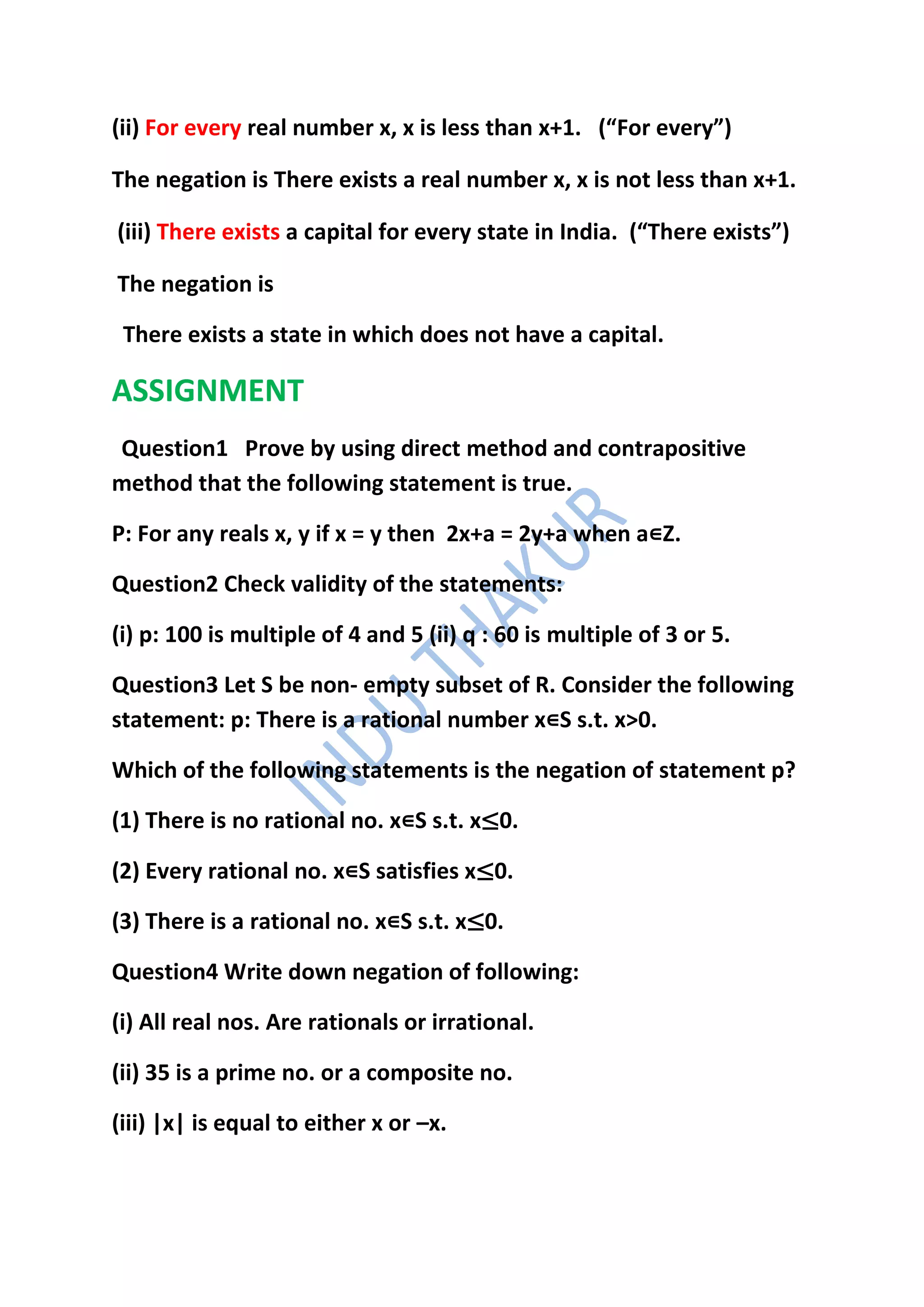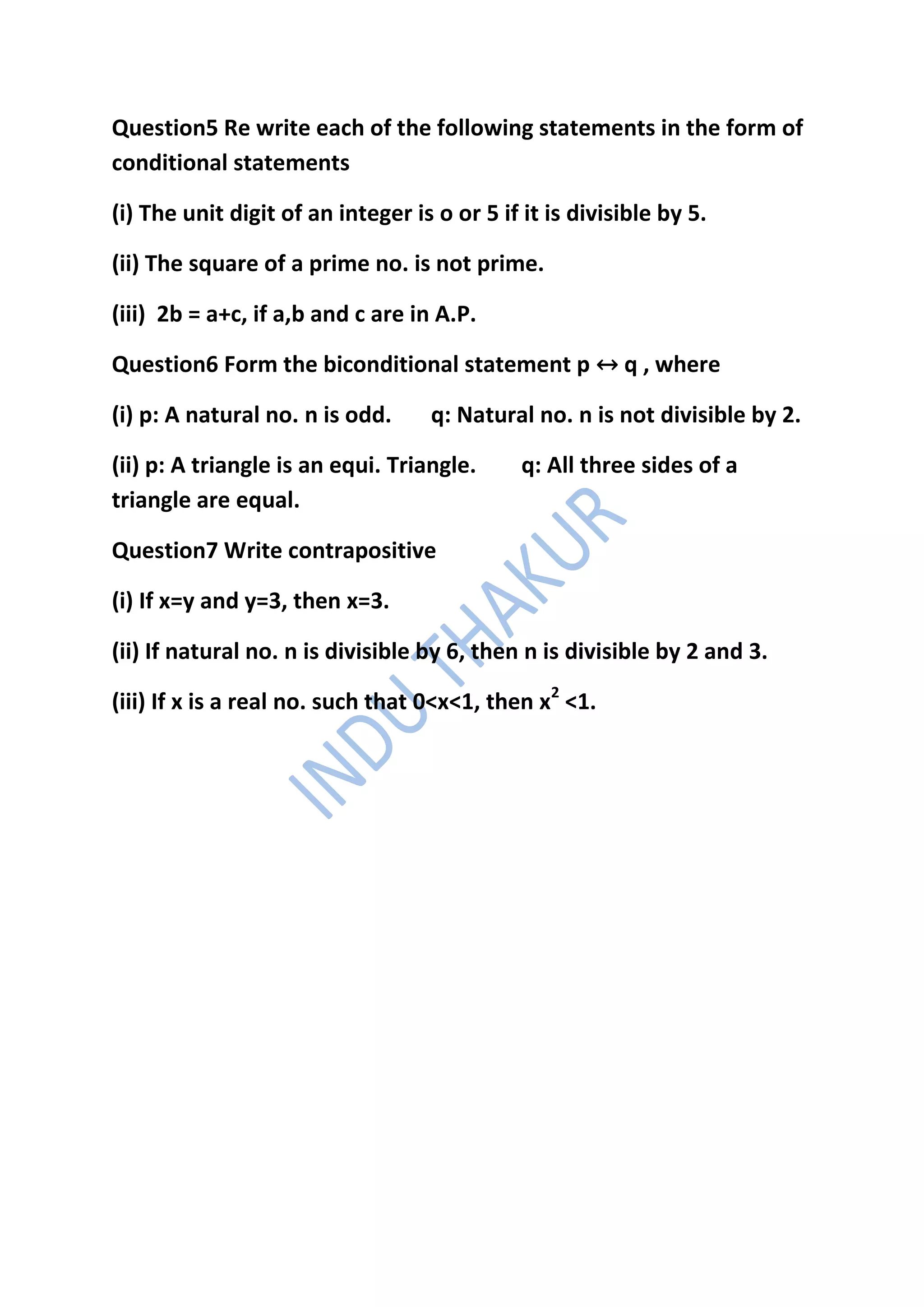1) There are two main types of mathematical reasoning: deductive reasoning and inductive reasoning. Deductive reasoning develops proofs through logical implications, while inductive reasoning develops conjectures by observing patterns across examples.
2) Deductive reasoning involves deriving valid conclusions from general statements, like the classic example "All men are mortal, Socrates is a man, therefore Socrates is mortal".
3) Mathematical reasoning is primarily based on deductive reasoning through statements, definitions, axioms, theorems, and proofs. Key concepts include logical operations on statements, quantifiers, conditionals, and proving/disproving statements.
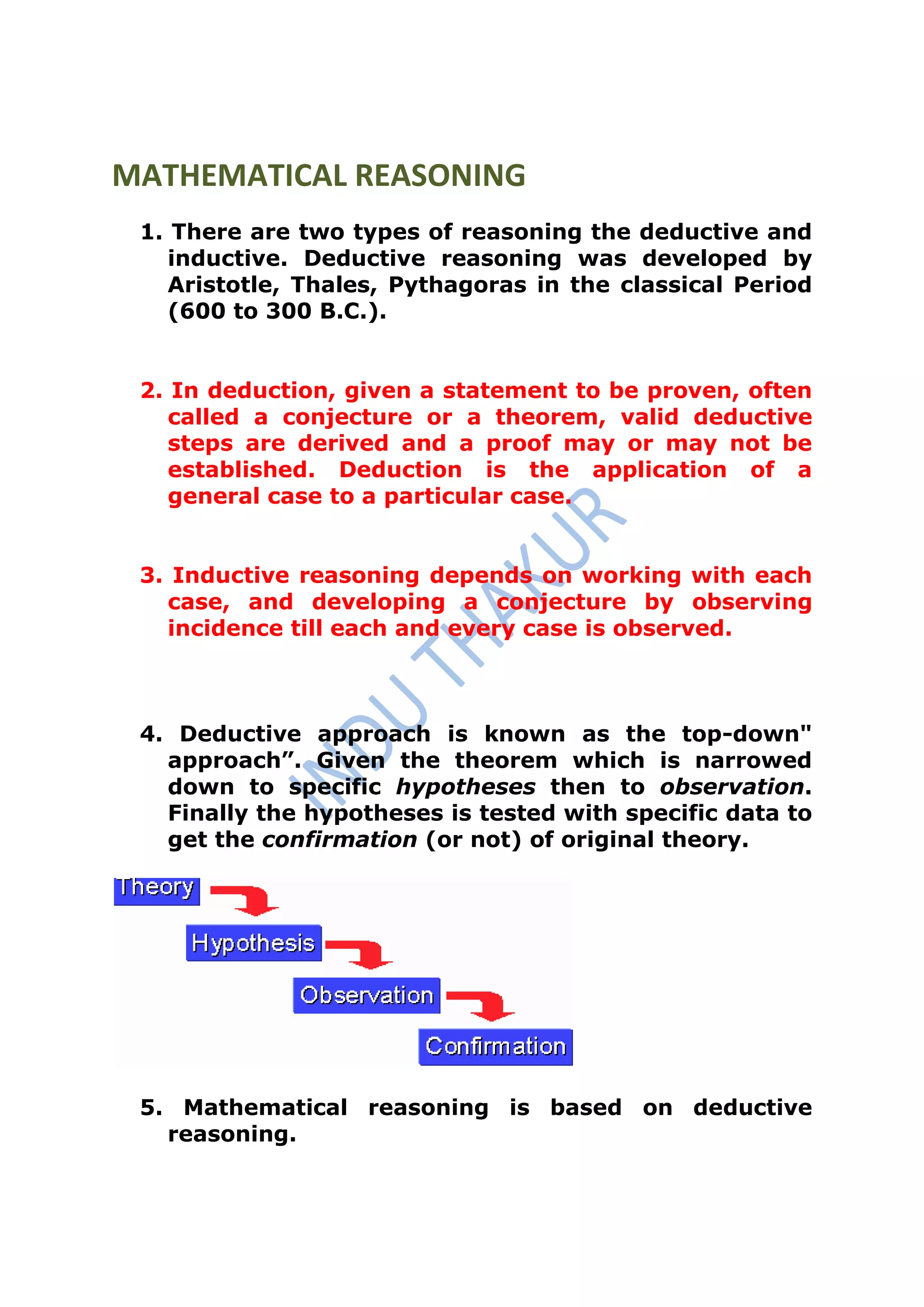
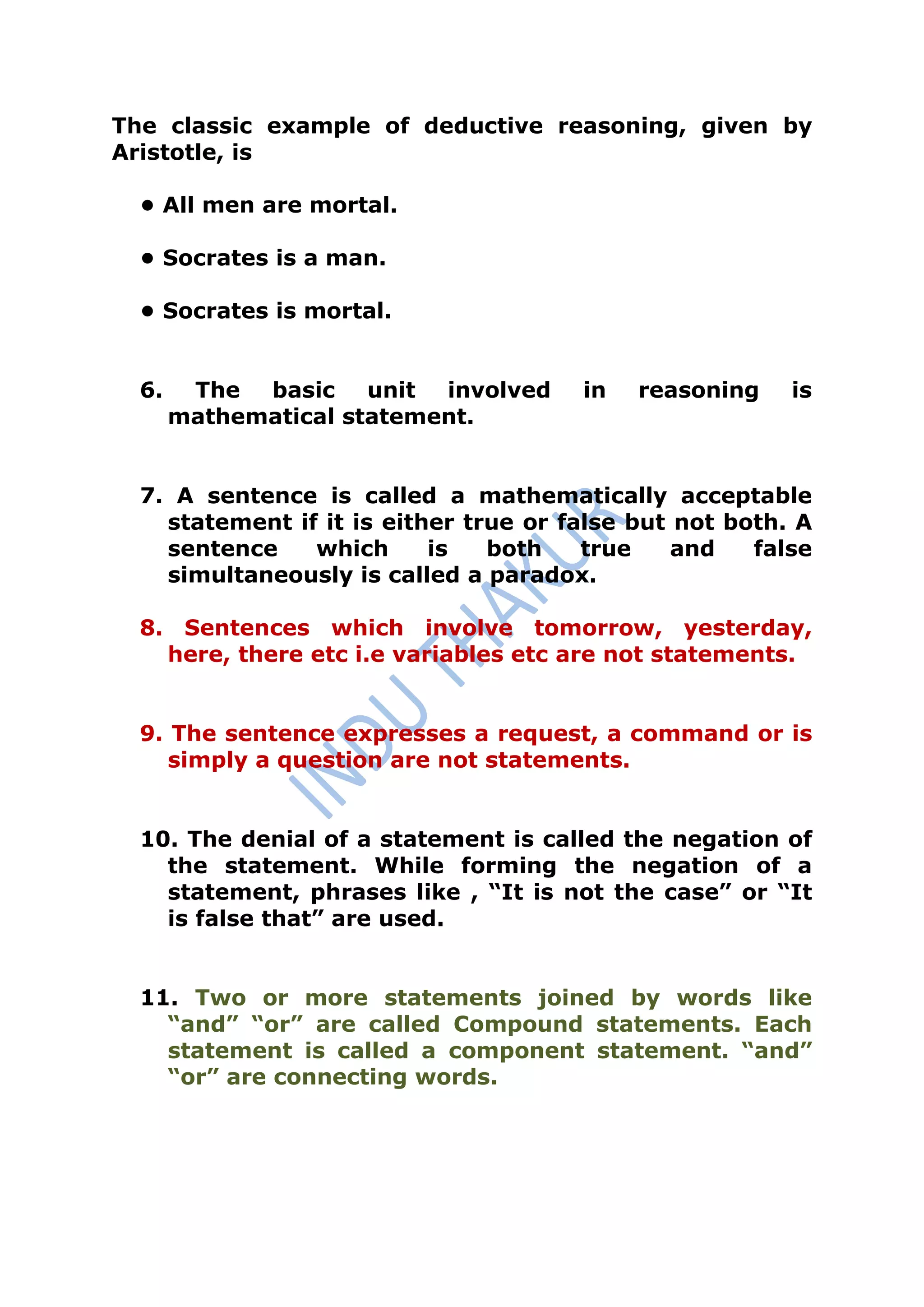
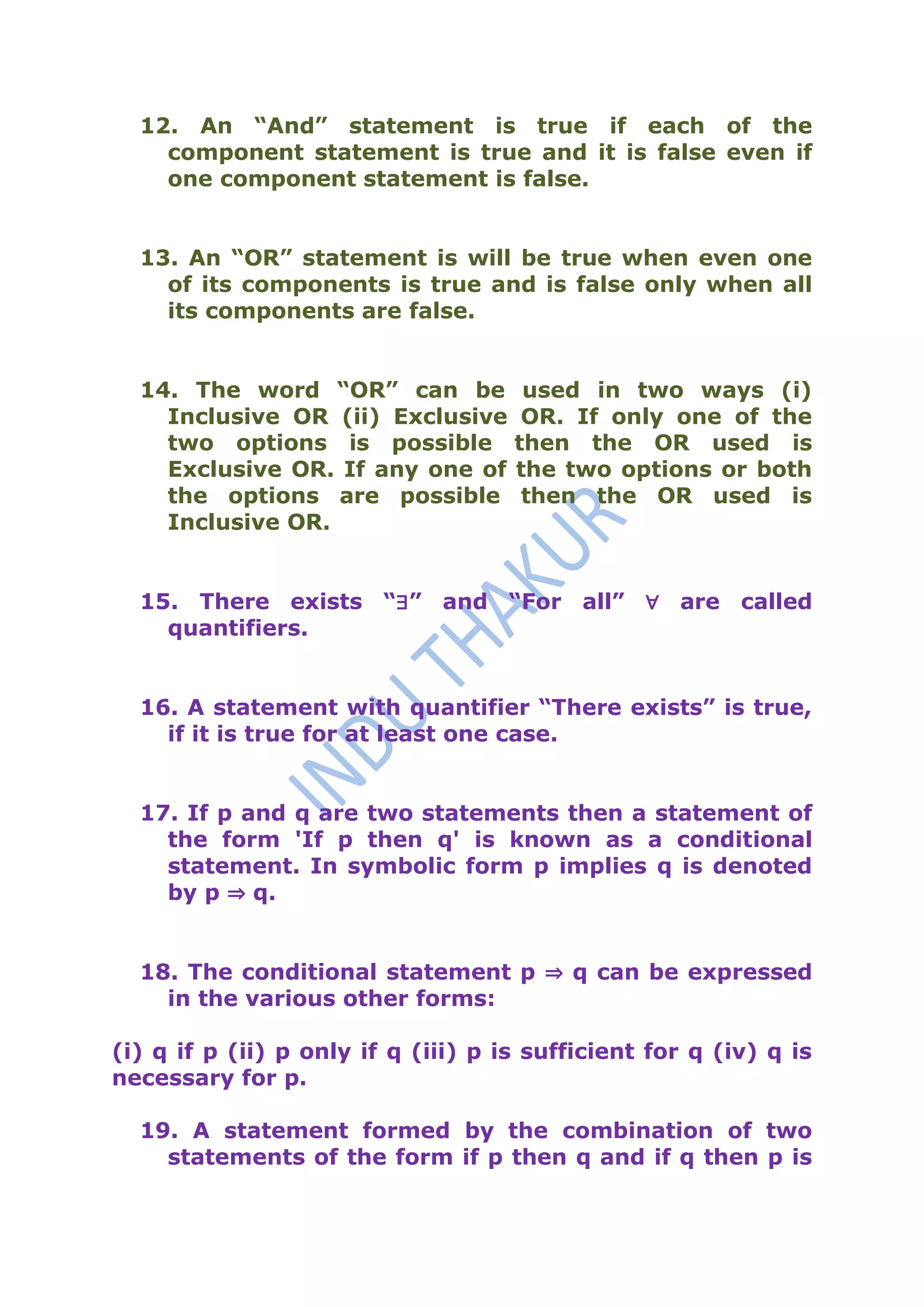

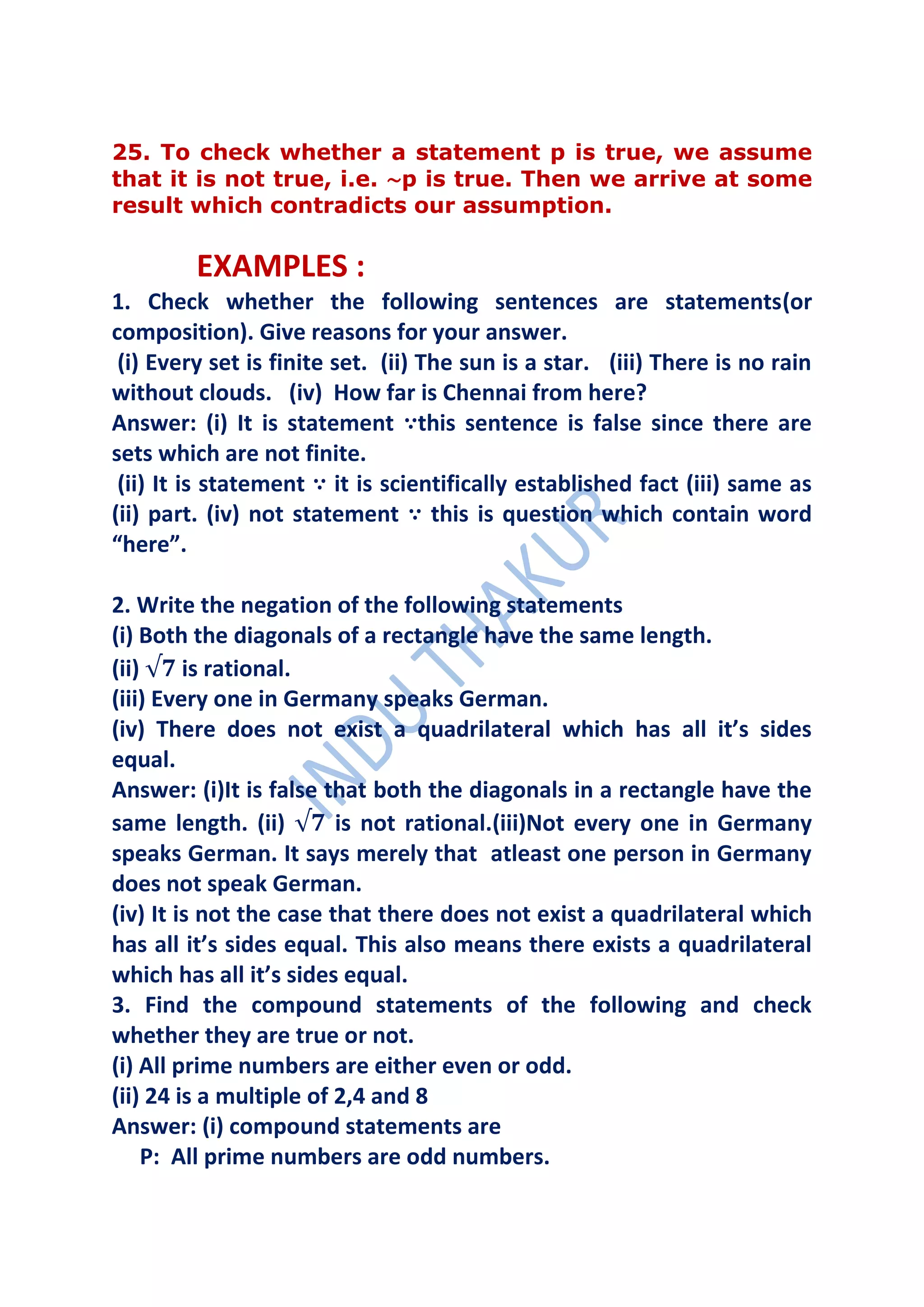
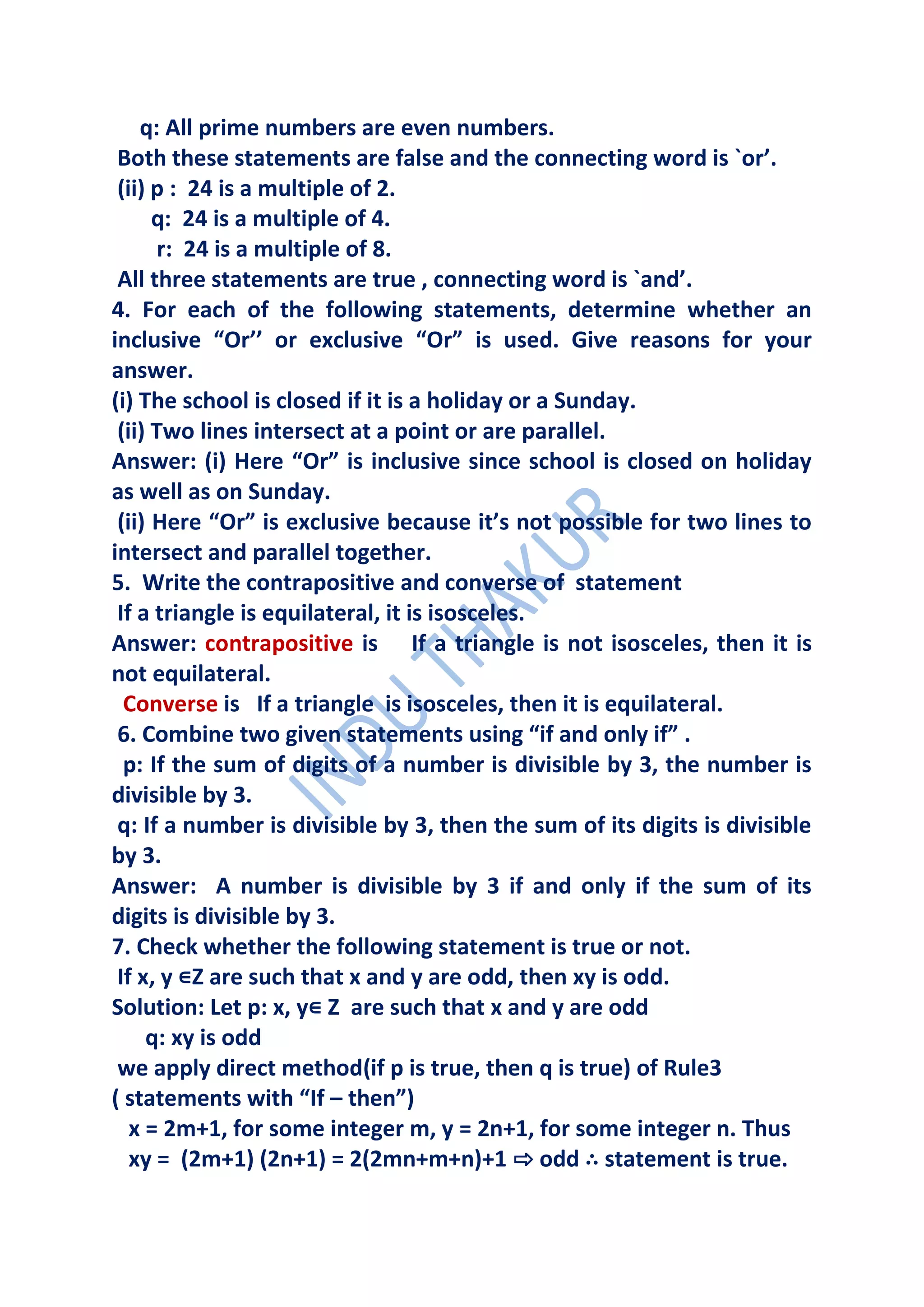
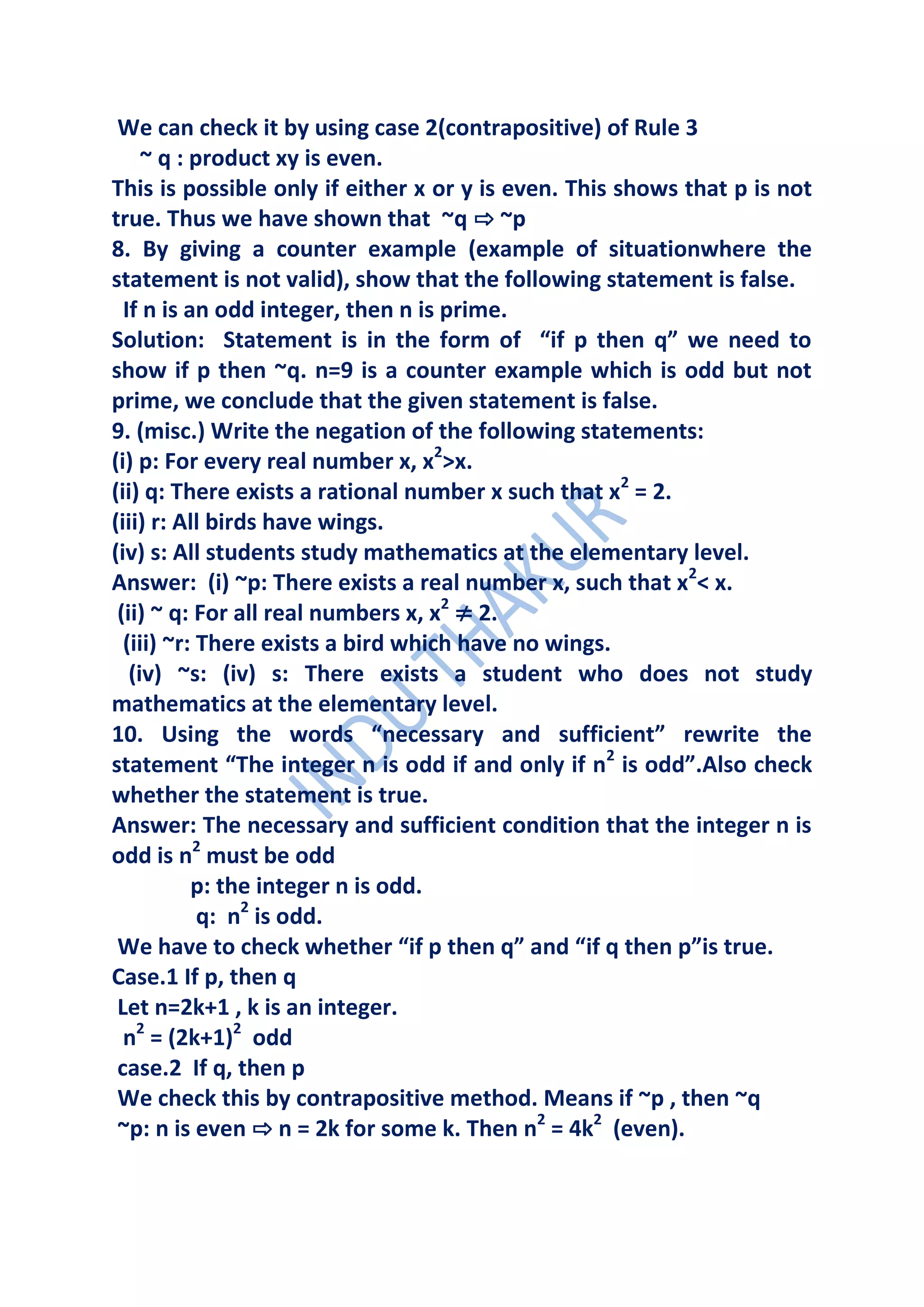
![11.Write the component statements of the following compound
statement “All prime numbers are either even or odd”.
Answer: The component statements are
P: All prime numbers are even number.
q: All prime numbers are odd number.
Both these statements are false and the connecting word is `or’.
**Biconditional of statement:
P: Today is 14th of August. q: Tomorrow is Independence day.
Is p ↔ q is given by “Today is 14th of August iff tomorrow is
Independence day”.
Questions(NCERT)
Question1: Give three examples of sentences which are not
statements. Give reasons for the answer.
(i) Do your duty. [∵ it is an order.]
(ii) How is your friend? [∵ it is an interrogative type]
(iii) How beautiful ! [∵ it is an exclamation]
Question2: Are the following pairs of statements negations of each
other?
(i) The number x is not a rational number. (YES)
The number x is not an irrational number.
(ii) The number x is a rational number. (YES)
The number x is an irrational number.
Answer: (i) yes, p: The number x is not a rational number.](https://image.slidesharecdn.com/mathmaticalreasoning-110816112231-phpapp02/75/Mathmatical-reasoning-8-2048.jpg)
![~p: The number x is a rational number.(Same as second statement)
Question :
For each of the following compound statements first identify the
connecting words and then break it into component statements.
(i) All rational numbers are real and all real numbers are not
complex.
(ii) Square of an integer is positive or negative.
(iii) The sand heats up quickly in the Sun and does not cool down
fast at night.
(iv) x = 2 and x = 3 are the roots of the equation 3x2 – x – 10 = 0.
Question :
Check whether the following pair of statements is negation of each
other. Give reasons for the answer.
(i) x + y = y + x is true for every real numbers x and y.
(ii) There exists real number x and y for which x + y = y + x. [NO]
Answer: Negation of (i) is x + y = y + x is not true for every real
numbers x and y.
Negation of (ii) is There does not exist real numbers x and y for
which x + y = y + x.
Question :
Show that the statement
p: “If x is a real number such that x3 + 4x = 0, then x is 0” is true by](https://image.slidesharecdn.com/mathmaticalreasoning-110816112231-phpapp02/75/Mathmatical-reasoning-9-2048.jpg)
![(i) direct method
(ii) method of contradiction
(iii) method of contrapositive
Solution: Let q: x is a real no. such that x3+4x=0. r: x is 0. , then, p:
if q,then r .
(i) direct method: q is true ⇨ x(x2+4) = 0 ⇨x=0 [∵ x is real], so r is
true, hence p is true.
(ii) method of contradiction: Let p be not true ⇨ ~p is true
⇨ ~(q ⇨ r) [∵p:q⇨r] ⇨ q and ~r is true [∵~(q ⇨ r)= q and ~r]
⇨ x is a real number such that x3+4x=0 and x≠0⇨ x=0 and x≠0.
(iii) method of contrapositive: Let r be not true. Then,
R is not true
⇨ x≠0, x∊ R ⇨ x(x2+4)≠0, x∊R ⇨ q is not true.
Thus, ~r ⇨ ~q. hence p: q⇨ r is true.
Question :
Show that the following statement is true by the method of
contrapositive.
p: If x is an integer and x2 is even, then x is also even.
Solution: p: x is an integer and x2 is even , q: x is even.
Let q is false ∴ ~q is true , ∴ x is odd integer, let x=2k+1, x2 = (2k+1)2
∴ p is false. Thus ~ q ⇨ ~p.
Question :](https://image.slidesharecdn.com/mathmaticalreasoning-110816112231-phpapp02/75/Mathmatical-reasoning-10-2048.jpg)
![Which of the following statements are true and which are false? In
each case give a valid reason for saying so.
(i) p: Each radius of a circle is a chord of the circle.
(ii) q: The centre of a circle bisects each chord of the circle.
(iii) r: Circle is a particular case of an ellipse.
(iv) s: If x and y are integers such that x > y, then –x < –y.
(v) t: is a rational number.
Answer: (i) F (ii) F [ a chord may or may not pass thro. The centre of
the circle] (iii) T [ when major axis = minor axis](iv) T (V) F [contrad.]
Question :
State the converse, inverse and contrapositive of each of the
following statements:
(i) p: A positive integer is prime only if it has no divisors other than
1 and itself.
(ii) q: I go to beach whenever it is a sunny day.
(iii) r: If it is hot outside, then you feel thirsty.
(iv) s: If x < y, then x2<y2.
Answer: (i) Converse: If a positive integer has no divisors other
than 1 and itself, then it is prime.
Inverse: If a positive integer is not prime, then it has divisors other
than 1 and itself.
Contrapositive: If a positive integer has divisors other than 1 and
itself, then it is not a prime.
(ii) Converse: If I go to beach, then it is a sunny day.](https://image.slidesharecdn.com/mathmaticalreasoning-110816112231-phpapp02/75/Mathmatical-reasoning-11-2048.jpg)
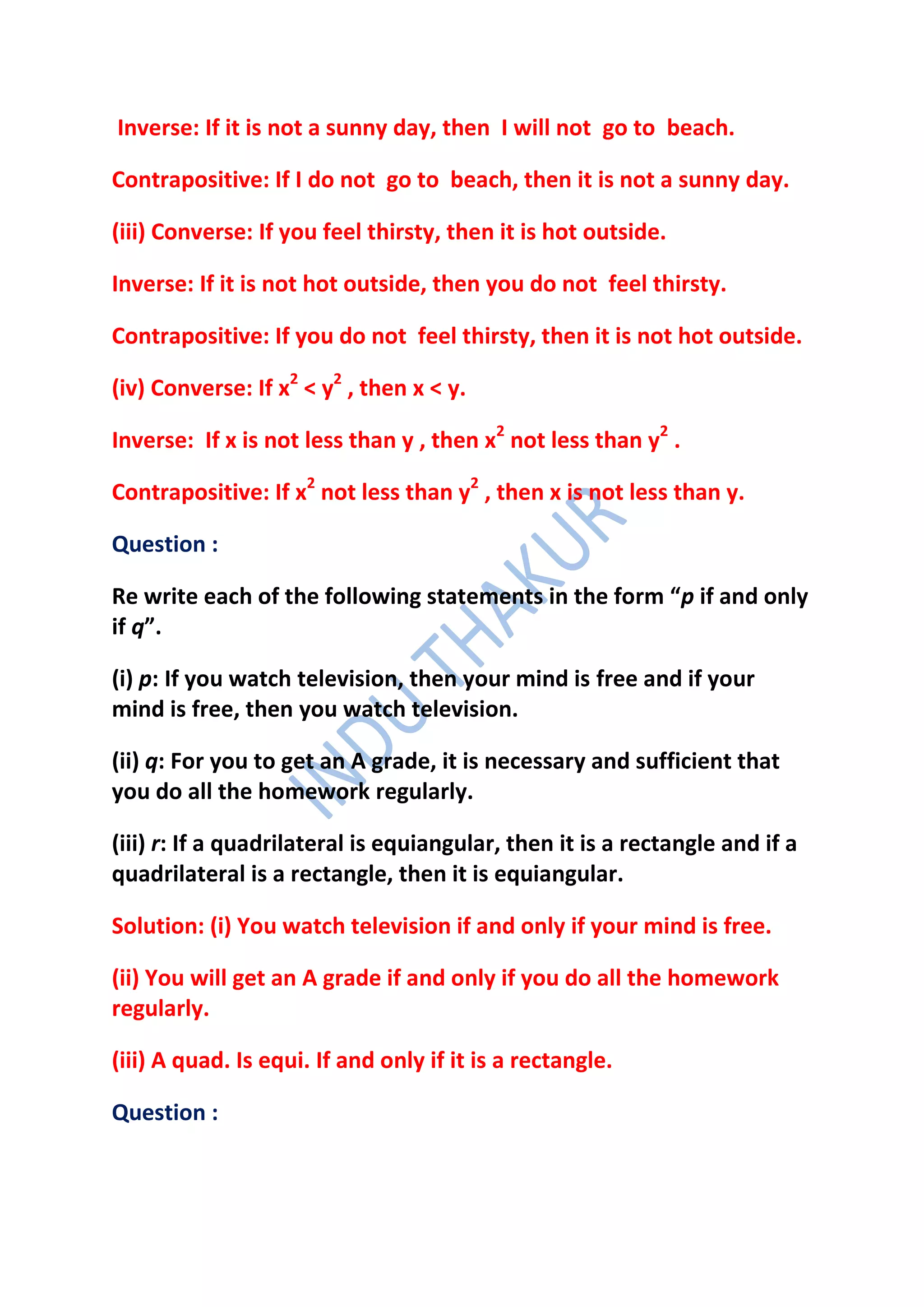
![Check the validity of the statements given below by the method
given against it.
(i) p: The sum of an irrational number and a rational number is
irrational (by contradiction method).
(ii) q: If n is a real number with n > 3, then n2 > 9 (by contradiction
method).
Answer: (i) Let statement be false i.e., irrat.+rat.number is rational.
An irrational no. = rational no. – rational no. = rational no.
Not possible ∴ we arrive at contradiction ∴ statement is wrong
(ii) Let if possible n2 > 9 is false ∴ n2 ≤ 9⇨ n2 - 9≤0 ⇨ (n-3)(n+3)≤0
⇨ n+3≤0 [n > 3] , not possible ∴supposition is wrong, hence true.
Question :
Write the following statement in five different ways, conveying the
same meaning.
p: If triangle is equiangular, then it is an obtuse angled triangle.
Answer: Let p: triangle is equiangular.
q: it is an obtuse angled triangle.
(i) p ⇨ q (ii) p is sufficient condition for q (iii) p only if q (iv) q is
necessary condition for p (v) ~q⇨ ~p
Question: Identify the quantifier in the following statements and
write the negation of the statements.
(i) There exists a number which is equal to its square.
The negation is There does not exist a number which is equal to its
square. The quantifier is (“There exists”)](https://image.slidesharecdn.com/mathmaticalreasoning-110816112231-phpapp02/75/Mathmatical-reasoning-13-2048.jpg)
